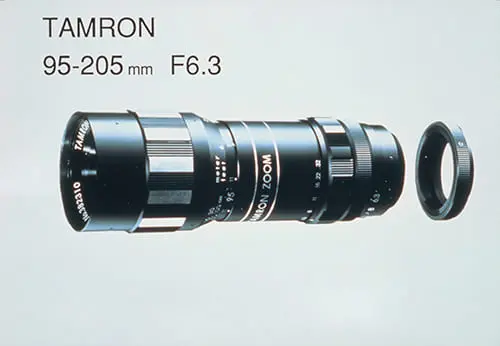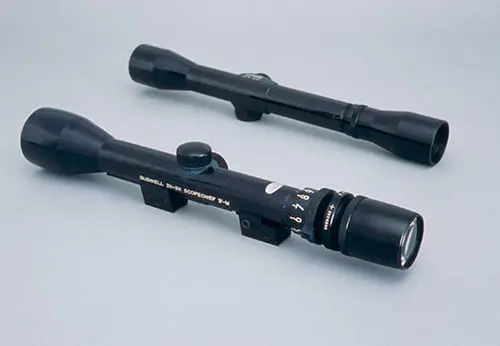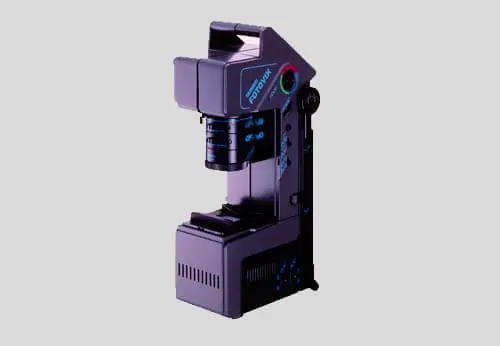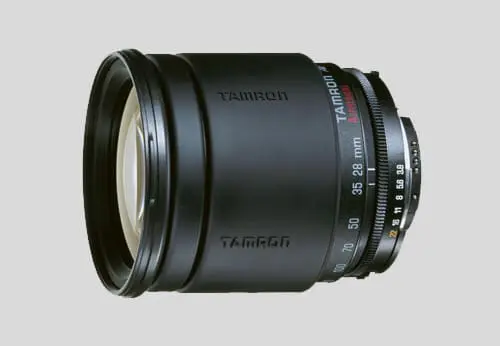| November, 1950 |
Taisei Optical Equipment Manufacturing is established in Urawa-city by Mr. Fujio Watanabe and Mr. Takeyuki Arai Manufacture of cameras and binocular lenses starts |
|---|---|
| October, 1952 | Taisei Optical Equipment Manufacturing Inc. is established with capital of 2.5 million yen |
| 1957 |
135mm F/4.5 is developed for 35mm single-lens reflex cameras The 'T' mount, the world's first interchangeable lenses for 35mm single-lens reflex cameras, is developed |
| August, 1958 | TAMRON Brand is registered as trademark |
| September, 1959 |
Head office and main plant are established in Hasunuma, Omiya-city Mass production of 95-205mm F/6.3 the first affordable telephoto zoom lens for single-lens reflex cameras, starts a zoom lenses |
| May, 1966 |
Production of test plates, ultra-precision lenses and prisms begins Production of 'TAMRON Adapt-A-Matic' range of interchangeable mount lenses, providing auto-focus capabilities for various single-lens reflex cameras begins Production of television broadcasting lenses for ITV begins |
| May, 1969 |
Hirosaki Plant is established in Aomori Prefecture Production of interchangeable lenses for single-lens reflex cameras, television lenses and photocopier lenses, etc., begins |
| April, 1970 | The Company name is changed to Tamron Co., Ltd. |
| September, 1976 | Head Office transferred to Takinogawa, Kita-ku, Tokyo |
| 1976 | The TAMRON Adaptall Lens' range with built-in lightweight macro-mechanism and exclusive quick-focus system is introduced |
| April, 1979 |
U.S. subsidiary, Tamron Industries, Inc., is established in New York 'Super-Performance (SP)' series is introduced |
| January, 1981 | No. 2 Production Building is established at Hirosaki Plant |
|---|---|
| September, 1982 | Tamron Vertriebsges, GmbH. is established in Germany |
| November, 1982 | TAMRON INDUSTRIES (HONKG KONG) LIMITED is established |
| 1983 | Integrated video camera lens is developed |
| February, 1984 | Optech Tamron Co., Ltd. is established in Namioka-machi, Aomori Prefecture |
| August, 1984 | TAMRON registers with the Tokyo stock Exchange for over-the-counter trading and capital is increased to 3,835,575,000 yen |
| December, 1985 | Tamron Fine-Giken Co., Ltd. is established to produce molds and dies for precision moldings |
| January, 1986 | Molding plant is established in Owani-machi, Aomori Prefecture |
| April, 1995 | Tamron U.K. Ltd. is established in the United Kingdom |
| July, 1995 | TAMRON enters the medium-format camera business after acquiring shares in the long-established Bronica Co., Ltd. |
| November, 1995 | Hirosaki Plant achieve ISO9001 certification |
| May, 1997 | TAMRON INDUSTRIES (HONKG KONG) LIMITED is established in Hong Kong |
| July, 1997 | Tamron Optical (Foshan) Co. Ltd. is established in Foshan, Quang Dong, Peoples Republic of China |
| July, 1998 | Bronica Co., Ltd. is merged into Tamron Co., Ltd. |
| June, 2000 | TAMRON France EURL. is established |
| September, 2000 | Head office achieves ISO 9001 certification |
| December, 2000 | Tamron's Hirosaki Plant achieves ISO 14001 certification |
| September, 2001 | TAMRON OPTICAL (FOSHAN) CO.,LTD. achieve ISO9001 & ISO14001 certification |
| October, 2001 | Head Office achieve ISO14001 certification |
| November, 2003 | Namioka Plant and Owani Plant achieve ISO14001 certification |
| January, 2004 | Namioka Plant and Owani Plant achieve ISO9001 certification |
| April, 2005 | Head Office transferred to Hasunuma, Minuma-ku, Saitama City, Saitama Prefecture |
| October, 2005 | TAMRON OPTICAL (SHANGHAI) CO., LTD. is established |
| November, 2006 | TAMRON listed on the 1st Section of Tokyo Stock Exchange |
| November, 2007 | New production plant of TAMRON OPTICAL (FOSHAN) CO., LTD. Begins Operation |
| August, 2009 | Acquires certification of ISO/TS16949, a quality management system for the automotive industry |
| March, 2012 | TAMRON (Russia) LLC., is established |
|---|---|
| May, 2012 | TAMRON OPTICAL (VIETNAM) CO., LTD. is established |
| March, 2013 | TAMRON INDIA PRIVATE LIMITED is established |
| March, 2015 | Kouyu Kosan Co., Ltd. stock acquisition, becoming a Tamron Co., Ltd. Subsidiary |
| June, 2015 | Kouyu Kosan Co., Ltd. merged into Tamron Co., Ltd. |
| May, 2017 | TOUMEIGIKEN Co., Ltd. stock acquisition, becoming a Tamron Co., Ltd. Subsidiary |
| March, 2020 | New Well Co., Ltd. stock acquisition, becoming a Tamron Co., Ltd. Subsidiary |
| July, 2020 | Tamron Co., Ltd. liquidates New Well Co., Ltd. |
| June, 2021 | Acquires certification of ISO 13485:2016, the international standard of quality management systems for medical devices |
| April, 2022 | Tamron Co., Ltd. moves to the Prime Market of Tokyo Stock Exchange |



Takeyuki Arai, a visionary founding member, leveraged his wartime expertise in developing precision optical equipment to foresee the immense potential of lenses and the excellence of Japanese optical technologies. In November 1950, shortly after the war’s conclusion, he established a modest factory with 13 dedicated employees in Urawa (now Saitama City) in Saitama Prefecture. This venture marked the inception of Taisei Optical Equipment Manufacturing, the precursor to TAMRON.
Our early days were marked by subcontracting work, primarily polishing binocular lenses. Despite encountering numerous challenges, we remained steadfast, continually refining our lens manufacturing technologies. Our unwavering commitment to quality ensured that no product was released until it achieved a level of excellence, thus cementing our reputation for superior quality and reliability.
In 1952, Uhyoue Tamura joined our ranks, laying the cornerstone for TAMRON’s future in optical technology. We then established an optical design division and embarked on the independent development of binoculars. By 1953, we had successfully introduced our first product, the Wide Vision Binoculars 7×35 11°. Its widespread acclaim provided the momentum for our future endeavors. Following this success, we advanced into the realm of camera lens processing, eventually pioneering the manufacture of lenses for SLR cameras.









In the 1950s, Japanese cameras and lenses ascended to prominence, thanks in large part to the highly esteemed photojournalism of Korean War correspondents. Prior to this, German cameras and lenses had reigned supreme. However, the remarkable performance of Japanese cameras garnered widespread acclaim among U.S. military personnel stationed in Japan, precipitating a surge in demand. This led to fierce competition among leading camera manufacturers to develop single-lens reflex cameras.
Takeyuki Arai, one of our illustrious founders, chose to diverge from the path of major camera manufacturers by pioneering the development and production of telephoto lenses, an area largely neglected by others. Initially, our monthly production was modest, at approximately 300 units. Subsequently, we consolidated our factories in Akabane and Yono and relocated to Urawa, where we established an integrated production structure for camera lenses. Within this framework, we created TAMRON’s inaugural interchangeable lens, the 135 mm F/4.5 (Model #280). This telephoto lens introduced the T-mount, the world’s first universal interchangeable lens mount system for SLR cameras. The T-mount allowed lenses to be effortlessly attached to cameras from various manufacturers by simply changing the lens mount. To commercialize and globalize this lens and the T-mount, they were named TAMRON after lens designer Uhyoue Tamura. This marked the commencement of our extensive development, production, and sales of interchangeable lenses, including the 200 mm F/2.8 (Model #360) and the 400 mm F/5.6 (Model #340), among other telephoto lenses. During this period, we also introduced the 95-205 mm F/6.3 (Model #910P), the industry’s first affordable telephoto zoom lens.
In the 1960s, we achieved a significant breakthrough by developing the TAMRON Adapt-A-Matic range of lenses. The Adapt-A-Matic was a universal interchangeable lens mount system for SLR cameras that supported auto-focus.
This era witnessed not only professional photographers but also general consumers embracing cameras for family photography. With the advent of stable mass production and supply, cameras gained immense popularity, particularly with the introduction of reasonably priced models.
Around this time, we began to broaden our global perspective. We embarked on the development, manufacturing, and mass production of spotting scopes, primarily for the U.S. market. During that era, spotting scopes were considered luxury items, and our products were highly esteemed for their Japanese craftsmanship. In the late 1960s, we initiated the production of lenses for ITV and television broadcasting, leveraging our advanced optical technologies. This endeavor laid the foundation for our expansion into lenses for surveillance cameras, factory automation, machine vision, automotive applications, drones, and various other industrial lenses.









In the 1970s, the photographic industry witnessed a significant transition from monochrome to color film. Simultaneously, TAMRON underwent a transformation, changing its name from Taisei Optical Equipment Manufacturing Inc. to Tamron Co., Ltd.
During this era, camera manufacturers began introducing cameras designed for ease of use, allowing everyday consumers to effortlessly capture beautiful photographs. TAMRON responded by developing, manufacturing, and releasing a multitude of interchangeable and industrial lenses to widespread acclaim.
On the technical front, notable advancements were made. Photographic camera lenses began to receive multilayered film coatings, significantly enhancing anti-reflection performance. Additionally, TAMRON’s development of the Adaptall mount system enabled full-aperture metering*, allowing photographers to achieve accurate exposure at their chosen aperture setting after metering with the aperture wide open. This period also saw the introduction of the TAMRON Adaptall Lens range, featuring a macro mechanism and an exclusive quick-focus system. TAMRON continued to innovate with the Superior Performance (SP) series, which offered advanced design specifications.
In 1979, TAMRON introduced the 90mm F/2.5 (Model 52B) semi-telephoto macro lens, specifically designed for portrait photography. This lens marked the debut of the now-iconic 90mm macro lens, affectionately known to its enthusiasts as “Tamukyu.”
At the time, macro lenses were primarily viewed as specialized tools for document photography, known for their high contrast and perceived unsuitability for general photography. Additionally, their high cost and lack of versatility deterred many photographers. Addressing these concerns, TAMRON extended the Gauss-type optical system used in regular semi-telephoto lenses and implemented close-distance correction to create a lens suitable for both macro and general photography. The result was a versatile, compact lens capable of producing beautifully soft background blur (bokeh) and sharp, in-focus subjects. The release of the 90mm F/2.5 (Model 52B) eliminated the need to switch to a high-magnification lens for close-up portrait photography, fulfilling photographers’ desire for a semi-telephoto lens with a short minimum focus distance. The legacy of this lens endures, with TAMRON continuing to develop and release macro lenses that incorporate the latest technologies and meet contemporary needs, maintaining a cherished place among its many fans.
The 1980s heralded the advent of camcorders, combining video cameras with video tape recorders. TAMRON expanded its focus beyond photographic camera lenses, venturing into camcorder development. These efforts later proved fruitful, becoming a cornerstone of TAMRON’s industrial product offerings. TAMRON also introduced innovative products such as the Fotovix film video processor, which projected film onto a television screen, and an auto-focusing microscope. This era showcased TAMRON’s commitment to leveraging optical technologies to benefit industry and society.
In 1992, TAMRON released the 28-200mm F/3.5-5.6 Aspherical (Model 71D) all-in-one zoom lens, a product that epitomized TAMRON’s ingenuity. Although all-in-one zoom lenses existed, their bulkiness limited their versatility. Driven by a personal anecdote involving the former president’s wife struggling to switch lenses at their son’s graduation, TAMRON set out to develop a compact, lightweight, and versatile all-in-one zoom lens. The resulting Model 71D lens earned widespread acclaim overseas and eventually gained popularity in Japan, celebrated for its high performance and excellent image quality.
* Full-aperture metering: A metering system that allows a photographer to perform metering at their desired aperture number while the lens aperture remains wide open.









In the mid-1990s, the video industry was swept by the digitalization wave. The transition from manual focus to auto-focus gained momentum, and film transitioned to digital formats. This shift significantly impacted interchangeable lenses for digital SLR cameras, driving advancements in technology. Rapid digitalization accelerated automation and computerization, demanding more precise performance. To continue delivering innovative lenses globally, TAMRON underwent a significant transformation. In 2005, the company began in-house production of high-performance vibration compensation mechanisms and actuators (motor drive devices) for auto-focus. In 2007, they released the high-power zoom lens AF28-300mm F/3.5-6.3 XR Di VC LD Aspherical [IF] MACRO (Model A20), featuring TAMRON’s proprietary vibration compensation (VC) mechanism. Since then, TAMRON has received prestigious accolades, including the EISA Awards, a leading European recognition for photo and video products.
TAMRON’s advanced production technologies enabled the mass production of complex lenses. The ability to internally manufacture the large-aperture Molded-Glass Aspherical element, which controls spherical and distortion aberrations while enhancing resolution, allowed the company to offer high-performance, high-speed, ultra-wide-angle zoom lenses. Original products like the SP 150-600mm F/5-6.3 Di VC USD (Model A011), a compact and lightweight ultra-telephoto zoom lens designed for handheld shooting, were introduced in 2013. With the rise of high-resolution digital SLR cameras, TAMRON expanded its lens lineup to meet stringent image quality requirements, accommodating higher pixel cameras.
In the late 2000s, the photography landscape evolved. The proliferation of mobile phones and smartphones with camera functions led to a shift from traditional cameras to mobile devices for photography. Amidst this shift, compact mirrorless cameras, which eliminated the mirror mechanism of digital SLR cameras, emerged in the market, particularly full-frame mirrorless DSLRs. Emphasizing balance with the increasingly compact cameras, TAMRON launched the 28-75mm F/2.8 Di III RXD (A036) in 2018, combining compact size with high performance. This lens received high praise from customers and marked the expansion of TAMRON’s lens lineup for full-frame mirrorless DSLRs.
In the realm of industrial lenses, technological advancements enabled the creation of more compact and functional lenses for surveillance cameras, factory automation/machine vision, automotive applications, and drones. These lenses became increasingly integrated into daily life. TAMRON developed lenses for surveillance cameras that met market needs and lenses for machine vision cameras used in industrial applications. As automated driving technology advanced, TAMRON contributed to societal security and safety by producing optical products, including lenses for automotive applications that enable sensing, alongside conventional lenses for visual recognition applications.
Today, TAMRON continues to innovate, honoring the vision of its founder, who saw immense potential in Japanese optics over 70 years ago. The company leverages optical technologies to address societal challenges and strives to create a fulfilling society every day.
CCTV Camera Lenses
FA and Machine Vision Lens
Camera Module
Lenses for Automotive
Medical Devices
Optical Devices
Customised Products
Technology (Corporate)
Support/Contact
Copyright 2024 – TAMRON Europe GmbH